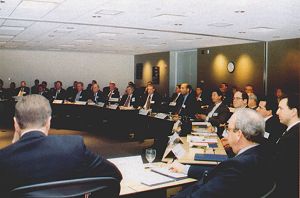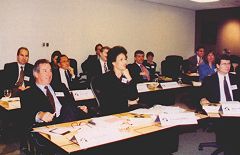| |
M A N A G E M E N T S T R A T E G Y Tomorrow’s corporate real estate world will scarcely resemble yesterday’s or today’s, the pundits are fond of pointing out. The professionals in the industry know that. The key is getting the rest of the organization to see the same vision. Corporate Real Estate at a Crossroadsb y M A R K A R E N D
Jones Lang Wootton (JLW), which is finalizing a merger with LaSalle Partners, organizes the Corporate Real Estate Leadership Forum annually. The theme of the November 1998 gathering was “Focus on Innovation,” a theme well chosen, given the period of transition both JLW and the corporate real estate industry are enduring.
Above left: Roundtable attendees from diverse corporate environments shared their strategies for improving ties to corporate business units.
More important still is the ability to work with business unit heads to obtain from them the intelligence needed to manage the CRE function in a non-threatening way. Conversely, working closely with business units now means providing department heads with intelligence they need to manage their domains cost effectively. In essence, what’s different about the old way of doing things and the new is the imperative to think about other organizational entities in a non-territorial context, which goes for non-CRE managers as well. The corporate real estate officer must be thought of as an ally, not an adversary, or dialogue will be reduced to discussions about cost-cutting, churn and who has the final say on new floor plans. Be Integral to the Game Plan “That means you have to be an integral part of the corporate game plan,” Dayton stressed to the CREs in the audience. Certain forces are givens in today’s industrial climate, he explained, including smaller facility footprints, price declines and shorter production cycles, not to mention third parties’ ability to do the same function more cheaply. So certain facilities will have to go, he related. “You can think through where that will happen to you, if you have a corporate team spirit.” Then, as if Janus himself had inspired Dayton’s remarks, the IBM veteran added this observation: “It’s easy to identify the macro trends. You have to have the confidence as a business that you’re right. Maybe you’re off by a year or two, but in the greater scheme of things that doesn’t matter. But you have to get out of the normal corporate process, frankly, to do this.” Having “the confidence as a business that you’re right” is no small matter when building a new corporate campus or closing plants and causing layoffs or acquiring a competitor — thereby doubling real estate assets — are involved. But the stronger the team, the better the decision — that’s one rule of business that likely won’t change. At all too many organizations, though, CREs are a step or two, or more, outside the loop. The good news is that’s changing. The Challenge to Demonstrate Value Changing business cycles and heightened merger activity in many industries complicate assigning values to the corporate real estate function’s contribution to organizations’ ability to meet their strategic goals, Murphy asserted. “But there is an opportunity for corporate real estate to become a strategic enabler,” she noted. Management has been heavily focused on maximizing shareholder value throughout the 1990s. “But senior management has come to realize there is a second bottom line — the workers.” By increasing efficiency, raising worker retention levels and implementing more innovative workplace strategies, “it is possible for CREs to provide more leverage and be at the forefront of corporate strategy.” Industry surveys, including an impromptu poll of Leadership Forum attendees, identify the following as issues the CRE profession considers to be priorities: improving service quality; improving physical asset utilization, cutting occupancy and operating costs; developing global facility operations; establishing a P&L structure for the corporate real estate unit; strategic planning; responding to corporate growth; developing alternative office strategies and implementing shared service models.
The Business Unit Buy-In “We try to market our contribution to the organization, what we do and the value we create — we promote ourselves,” related one participant. Another explained how the corporate real estate function has evolved at his organization, a money center bank, into a shared services model. “When we were an administrative services organization reporting to an executive vice president, we were protectors of the assets of the corporation,” he explained. “Shared services have turned that around to where we’re more transaction-oriented. It’s not that we’re not going to be part of the strategic planning, but once that process is established, it’s up to us to hit the ground running and bring the deal to pass. Our strategic involvement will be more in terms of not where properties are located and how big they are, but in terms of leases, expansion options and the like. We are supposed to look more and more like the service providers that come to us.” Another participant recalled business units’ attitude to involving corporate real estate in strategic planning in decades prior to the onset of business processing reengineering as one of blatant disinterest. Profits were rolling in, growth was strong, and business units had the freedom to build and expand as they saw fit. There was no mistaking business units’ reaction to CRE suggestions that future resource requirements be analyzed in a cross-functional team environment. “Doors were slammed,” he recalls. “When a [resource] measurement system was put in place in the early ’90s and a new CFO came in, suddenly the units were scurrying around, because part of their strategy was to reduce costs, and occupancy costs were one of their biggest. Suddenly they were knocking on our door.” Exactly, others concurred. “When they realized they had tremendous cost-cutting targets, we were the first ones they came to to ask how to do it,” another participant related. “The way to get their confidence is to produce better results,” he stressed. “Once you do that, they’ll knock on your door every time. It’s a self-fulfilling prophecy.” Tips for Forging Closer Ties “There is explicit authority, and there is implicit authority, and then there’s moral suasion,” Wenkstern observed. “Many times you have to use all three in order to accomplish something. If you don’t have the explicit authority, then you have a much harder row to hoe.” Summarizing other points made in the session, Wenkstern outlined several ways to forge closer ties to corporate business units. They include:
| |
| |
 | Site Selection Online | SiteNet |
|



 An almost palpable sense of “we’re all in this together” characterized the daylong event, which was held at IBM’s corporate headquarters campus in Armonk, N.Y. In a ski-lodge-like education center, located a short walk from Big Blue’s gleaming, new corporate headquarters building, corporate real estate executives struggled to find ways to better connect with the business units they serve back in their organizations, with senior management and with service providers they rely on for business solutions. Following a tour of the new IBM building, JLW executives moderated several discussions designed to add value to attendees’ corporate real estate experience.
An almost palpable sense of “we’re all in this together” characterized the daylong event, which was held at IBM’s corporate headquarters campus in Armonk, N.Y. In a ski-lodge-like education center, located a short walk from Big Blue’s gleaming, new corporate headquarters building, corporate real estate executives struggled to find ways to better connect with the business units they serve back in their organizations, with senior management and with service providers they rely on for business solutions. Following a tour of the new IBM building, JLW executives moderated several discussions designed to add value to attendees’ corporate real estate experience.  Still other challenges before the industry include devising new, non-square-footage-based work space measurements; working effectively with customers; evaluating internal strengths and weaknesses; and developing and implementing systems for delivering management-mandated projects. Looking objectively at their increasingly complex roles in their organizations, attendees were fast appreciating the importance of finding new ways to add and demonstrate value.
Still other challenges before the industry include devising new, non-square-footage-based work space measurements; working effectively with customers; evaluating internal strengths and weaknesses; and developing and implementing systems for delivering management-mandated projects. Looking objectively at their increasingly complex roles in their organizations, attendees were fast appreciating the importance of finding new ways to add and demonstrate value.